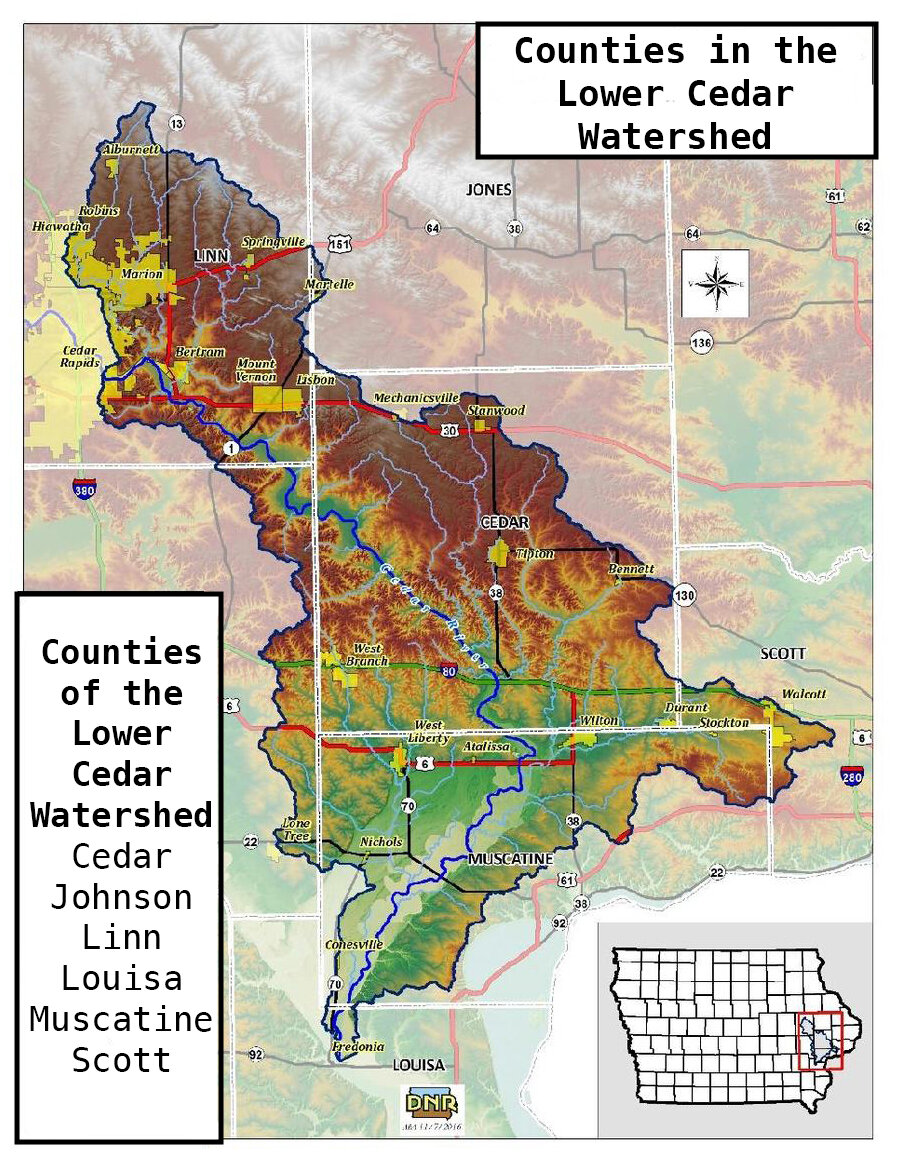Lower Cedar Watershed group holds winter banquet
The Lower Cedar Watershed Winter Banquet was held Thursday, Feb. 29, in the Durant Community Center, during which Heartland Co-Op praised the community.
“This is one of the most active and involved WMA’s,” said Ruth McCabe, “Everyone is interested, invested and concerned about making a difference.”
McCabe is the Conservation Manager for the Heartland Co-Op Conservation Team, which plays a special role in conservation across Iowa, which includes working with WMAs.
A WMA, or Watershed Management Authority, allows cities, counties, Soil and Water Conservation Districts and stakeholders to cooperatively engage in watershed planning.
A watershed is an area of land that drains or “sheds” water into a specific waterbody. In the case of the Lower Cedar Watershed, water drains into the Iowa River.
The Lower Cedar Watershed Management Authority, or Lower Cedar WMA for short, spans 703,060 acres, beginning in central Linn County and eventually joining with the Iowa River in northern Louisa County.
Though many counties are involved, the bulk of the Lower Cedar Watershed is in Muscatine and Cedar County.
Resource concerns in the watershed include flooding, high bacteria levels, excess nutrients (nitrogen and phosphorus), and erosion.
Jon Bell, Cedar County Superintendent and chair of the Lower Cedar Watershed took a few minutes to talk about the latest with the watershed.
“The water quality issues in Cedar County are being dealt with locally,” he said. “It’s exciting to see the organization moving forward; we’re actually seeing projects go out that are affecting the water quality.”
Specifically, he talked about the recent involvement by Heartland Co-op, which has hit the ground running with several projects in the last couple of years since it got involved.
One of those is the installation of saturated buffers and bioreactors, both of which help remove potentially harmful runoff from crops from reaching Iowa’s rivers.
“Right now, we have 17 landowners that are participating with 40 total structures in the watershed, and those will be built this year,” said Emery Davis, conservation agronomist with Heartland Co-Op.
“Those buffers are going to remove 32,000 pounds of nitrate per year, and treat over 1,600 acres,” he said.
Nitrates are compounds made from nitrogen and oxygen atoms. They are commonly found in vegetables, meat and drinking water.
Many studies suggest that nitrates benefit cardiovascular health. However, other studies suggest they may increase cancer risk. So, the buffers help limit nitrates in the water.
“When it’s all said and done, you won’t hardly see it, but that saturated buffer will be day-in and day-out cleaning the nitrates out of that water,” said Emery.
“It’s a great practice,” he added. “We really like these permanent structures that do work every single day.”
Working with private landowners in Iowa Water Quality watersheds, saturated buffers are being established and monitored as a nitrate management process within tile-drained watersheds.
The buffer also removes sediment, phosphorus and pesticides while creating a wildlife habitat, as well as slightly reducing flooding, according to Heartland Co-Op.
Meanwhile, Heartland Co-Op has worked with over 70 farmers to enroll 16,233 acres in the cover crop program for the fall of 2023, bringing $162,330 to farmers in the Lower Cedar Watershed.
Cover crops increase soil organic matter and improve soil fertility by capturing excess nutrients after a crop is harvested.
They also raise soil moisture holding capacity, help prevent soil erosion, limit nutrient runoff, reduce soil compaction and can even help suppress some pests.
During the 1860s, cover crops were a common practice in American agriculture until the 1950s, when conventional agriculture turned to synthetic fertilizers.
However, a 2013 Census of Agriculture revealed that 133,124 farms used cover crops 10.3 million acres nationwide, a practice that is currently growing once again.
“The real goal of the conservation program is to get physical practices in the ground,” said McCabe for Heartland Co-Op. “But, as part of that, there is outreach and education.”
“We’ve had 69 one-on-one farm meetings where we meet farmers on their farm,” said Emery. “I made more than 400 phone calls to folks in the watershed last year.”
The co-op has arranged several meetings with farmers and landowners in the watershed over the past couple of years, including the one that evening.
As for the Lower Cedar Watershed, much of it still in a severe of extreme drought despite record setting snowfall in January.
Yes, nearly two feet of snow fell over the period of a couple days, but the melt wasn’t enough to break the drought conditions.
However, the soil hadn’t frozen in most places, so most of the precipitation was able to soak into the ground rather than build up or run off into rivers.
As for Iowa, there are now over 28 established WMAs, including the Lower Cedar WMA. In 2010, Iowa lawmakers passed legislation authorizing the creation of WMAs.
While the driving motivation for WMA formation may be water quality improvement and/or flood risk reduction, there are multiple benefits according to the Iowa Department of Natural Resources (DNR).
One benefit is that a WMA allows conduct planning on a watershed scale, which has greater benefits for water quality improvement and flood risk reduction.
Other benefits include multi-jurisdictional partnership and cooperation, leveraging resources such as funding and technical expertise, and facilitating stakeholder involvement in watershed management.
The meeting in Durant was just one of many more to come due to the Lower Cedar Watershed, especially if Heartland Co-Op stays involved.
“We’re an easy button for farmers; we do as much as we possibly can to make it convenient,” said Emery about conservation projects.
“Our team is very grateful to provide watershed coordination services to this watershed,” added McCabe. “We have loved working here so far.”
Comments


